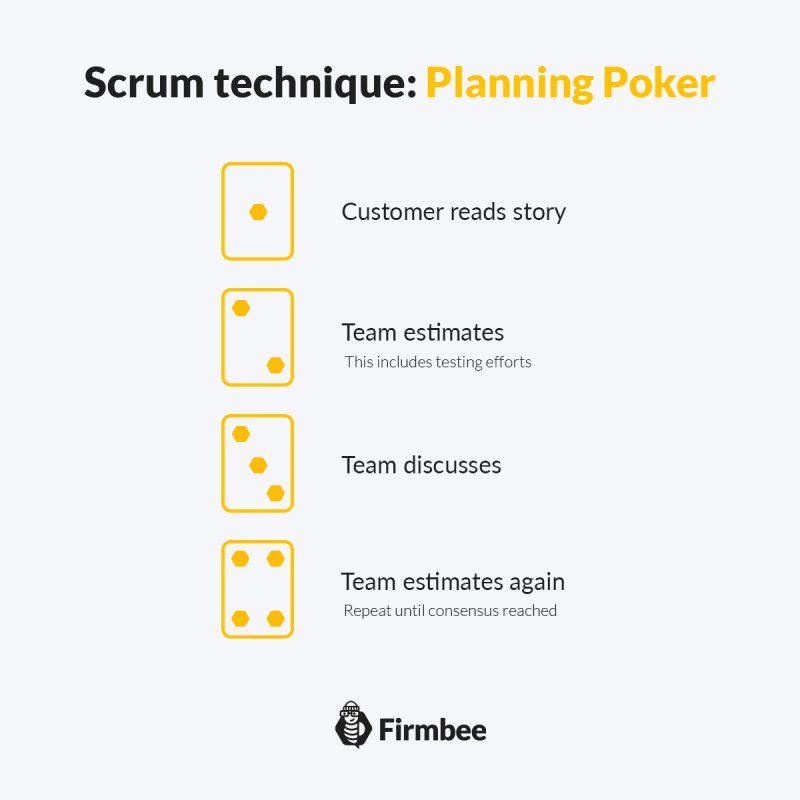Planning Poker is one of the most popular Scrum estimation techniques. It takes place during Sprint Planning and has a few simple rules. All players become members of the Development Team and each of them simultaneously puts on the table a card with the number of Story Points to estimate the task described by the Product Owner. What are the advantages and disadvantages of Planning Poker, and how to play it? Take look at our post to find out and master the technique.
Planning Poker – table of contents:
- Introduction
- How to play Planning Poker?
- Rules of Planning Poker
- Advantages and disadvantages of Planning Poker
- Summary
Introduction
Planning Poker, also called Scrum Poker or Pointing Poker is a relative technique for estimating the amount of work necessary to complete a specific task. It was created in 2022 by James Grenning. He wanted to solve the problem of endless disputes in the Scrum Team concerning the estimation of the difficulty of the tasks given to the Developers.
How to play Planning Poker?
The goal of Planning Poker is to estimate the difficulty and effort of each User Story selected for a given Sprint. The rules of playing Planning Poker are simple. However, first, you need to prepare the necessary accessories.
The Story Point cards usually contain values corresponding to the Fibonacci sequence, i.e. 0, 1, 3, 5, 8, 13, 20, 40, and 100. It also happens that they are marked with successive powers of 2, i.e. 2, 4, 8, 16, 32, and so on. Why aren’t they consecutive numbers? Because Planning Poker is all about clearly showing the differences between the difficulty of the tasks. And too small differences between card values would obscure the judgments.
Numbers usually express the number of Story Points. However, they can also be other units of measurement used by the Scrum Team. We wrote more about estimation units and Story Points in this article.
Rules of Planning Poker
Planning Poker game prompts:
- a deck of cards with User Stories – prepared separately for each game
- a deck of cards with Story Points – one deck for each Developer, for repeated use
The phases of Planning Poker:
- User Story presentation
- Discussion
- Gameplay (Phases 2 and 3 are repeated until reaching consensus by all)
- Consensus
- Moving on to the next User Story
Planning Poker usually takes place during Sprint Planning. The Product Owner holds the User Stories cards and the Developers receive a deck of cards with Story Points.
The moderator is the Product Owner who starts the game by presenting one User Story to the other Scrum Team members. If they have questions, they should speak out immediately after presenting a User Story.
The next step is to start a discussion about the implementation of the User Story. The whole Scrum Team participates in the discussion, but the main participants are the Developers. The discussion concerns, among others, such issues as:
- technical side of the task
- skills of individual Developers that will be necessary to complete the task
- ways of dealing with the expected difficulties
- additional tasks connected with User Story execution.
When the Developers agree on the most important issues, they each choose one of the cards from their Story Point deck. Then, they place it accordingly to their opinion over the User Story cad that best reflects its level of complexity.
The next step depends on how the cards got distributed:
- If the Developers placed cards of different values on the table, they return to the discussion. Then they take the cards off the table and re-estimate the value of the User Story. The situation repeats and the developers draw again until they reach a consensus.
- If the Developers agree on the User Story, they move on to the next round of Planning Poker. The Product Owner presents the next User Story, and the procedure repeats until the pool of User Stories planned for the current Sprint is exhausted.

Advantages and disadvantages of Planning Poker
The advantage of Planning Poker is undoubtedly the standardization of work with User Stories. The Development Team holds in their hands a ready-made set of cards for calculating the amount of work. This enables the values in every Sprint to remain constant and the Team learns to estimate with specific units.
Another important advantage is the equal participation of all Developers in estimating the task complexity. Even people who are not directly involved in its execution can contribute to the discussion. For example, by drawing attention to problems that did not occur because, for instance, Developers focused on the technical aspects of the task.
Another benefit of playing Planning Poker concerns developing the skill setting time limits on the discussion and, if necessary, limiting the number of rounds played for each User Story.
However, the time required to reach consensus is also one of the most frequently cited drawbacks of Planning Poker. If one or more Developers are unwilling to agree with the others, the game can potentially drag on indefinitely.

Summary
Planning Poker is a very effective relative estimation technique. The Development Team is provided with a ready-made framework of activities and point values for estimating the time and difficulty of tasks. This allows them to focus on problem-solving discussions as well as improve their estimations by comparing calculations and real-time User Stories.
If you like our content, join our busy bees community on Facebook, Twitter, LinkedIn, Instagram, YouTube, Pinterest.
Author: Caroline Becker
As a Project Manager, Caroline is an expert in finding new methods to design the best workflows and optimize processes. Her organizational skills and ability to work under time pressure make her the best person to turn complicated projects into reality.
Scrum Guide:
- Glossary of basic terms, roles and notions
- What is Scrum?
- Scrum values
- How to implement Scrum in your company?
- Scrum Team - what is it and how does it work?
- Who is a Product Owner?
- The most common mistakes of Product Owner
- Who is the Scrum Master?
- Characteristics of a good Scrum Master
- The most common mistakes of Scrum Master
- What statistics and metrics should the Scrum Master track?
- Cooperation between Product Owner and Scrum Master
- Development Team in Scrum
- The most common mistakes of Developers
- Scrum artifacts
- Scaling Scrum
- Sprint Backlog
- What is the Product Backlog?
- What are User Stories?
- Creating the best User Story with INVEST
- The most common User Story mistakes
- User Story Acceptance Criteria
- Estimation and Story Points in Scrum
- Planning Poker
- Team Estimation Game
- Defining Increment
- Scrum events
- What is Sprint in Scrum?
- Scrum Team Commitments - Product Goal, Sprint Goal and Definition of Completion
- What is a Burndown Chart?
- How to create and interpret a burndown chart?
- Advantages and disadvantages of the burndown chart
- Kanban boards in Scrum and Scrumban
- Velocity in Scrum - Speed of the Development Team
- Daily Scrum
- Sprint Planning
- Sprint Review
- What is a Sprint Retrospective?
- Common mistakes during a Sprint Retrospective
- Product Backlog nurturing


















